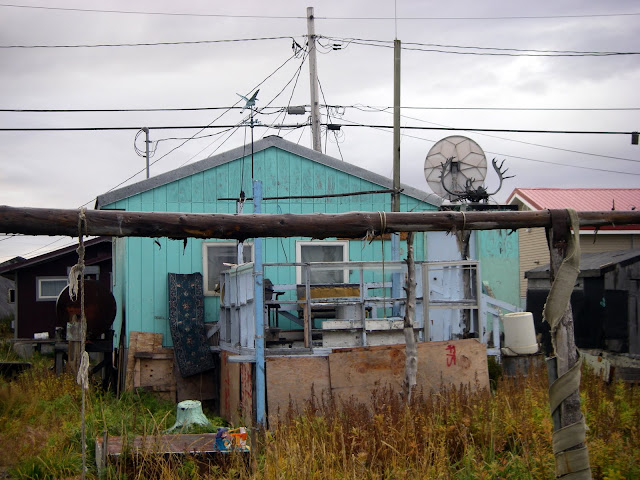


During the middle of September, Bucky, Carlisle and I had perhaps our most exciting adventure in Alaska to date. Knowing that our Fall stay would involve hunting, Carlisle set about this past winter designing a trip that would fit the desires of Team Doria. Many phone calls were made to hunters, air charter providers, Alaska Fish and Wildlife before Carlisle made her final decision. We were to fly to northwestern AK and float by raft on the Squirrel River which flows into the native village of Kiana. It was our hope to see lots of wildlife, no people and a friendly native village. With Carlisle as our outfitter, we spent days organizing our gear including our raft, our food, firearms and the many necessities needed to make a trip of this type safe and fun. As the weather had begun to reach into the 20's at night, warm clothes were needed. The challenge always is to travel as light as possible but still have the critical gear. We had concerns over our weight traveling from Anchorage to Kotzebue as we would be flying Alaska Air. Their policy is that anything over 100 pounds must go air cargo and we knew our raft was close to that. A final day of shopping in Anchorage before our early morning departure, secured our satellite phone, action packers and additional dry bags. Traveling by river added the need for all of our possessions to be in dry bags. Carlisle showed her expertise in organizing and outfitting us leaving no potential problem overlooked. It was the first time I had packed a stuff sack with down camp clothes to only be used when in the tent and to be kept dry at all times. We were uncertain as to if there would be wood available to build a fire meaning no way to dry oneself if wet. Without fire it's very easy to freeze. Our only knowledge of the area we were to be floating was through conversations Carlisle had had with Fish and Wildlife and by looking at topo maps. Our departure from Anchorage to Kotzebue, which appears in the upper left corner of the map, went quite smoothly. The raft weighed in at 102 pounds, but after being inspected by a supervisor, it traveled with us. We were excited to be underway having contacted Lee's Sea Air in Kotzebue with the understanding that we could be flown out to the river directly upon our arrival.
Kotzebue
Upon arriving in Kotz, we were met by Zaz Stahlie and her sister Lexy. Both girls are pilots and fly for their father. Much of their work is taking people from village to village and into Kotzebue. Today was particularly busy as they were moving families to the village of Selawick where 3 people had just died. Having no funeral homes, the men of the village build the coffin which the women line with cloth. The women also prepare the food and make arrangements for the visiting families to stay. It is an occasion that brings the whole village together in a time of great sadness. Zaz was ready to fly Carlisle and the raft to the river, about a 30 minute flight, which allowed time for Bucky and I to explore a bit of Kotz.
Main Street
Typical home
Within a little over an hour, Bucky and I were reunited with Carlisle on a gravel bar on the Squirrel River. Although Bucky and I have flown by bush plane many times before, I think this was our first time landing on a bar instead of on floats. We were happy to see Carlisle all smiles with the raft inflated.
 |
| Our guide:) |
the tundra
Zaz sets us down
 |
| Team Doria |
 |
A new friendship
The first 3 days of our float had us concerned as we had not seen much wildlife. The river banks were more Spruce than tundra favoring moose rather than the caribou that we were seeking. Despite this, we remained optimistic as each bend
in the river presented a new venue. Our campsites were varied, but all comfortable on dry gravel bars. We were evenable to build a few fires although the wind usually prohibited it. The water of the Squirrel was crystal clear and according to Zaz fine to drink. We treated our water, but didn't doubt that this was true. Looking down, we could see chum salmon in their final days, white fish and greyling. We were hoping to catch a shefish, but weren't able. Carlisle knew that the Squirrel was a "sleepy" river, but was surprised just how sleepy.
Grayling
|
 |
| Old hunting camp with bear damage |
On the ground outside the camp
 |
| Glorious sun! |
We saw some odd sights such as these antlers attached to heads left on the tundra, possibly from a past hunt
quite eerie
By day 5, we had found the caribou and Bucky successfully harvested one. Now, caring for the meat became a full time job. It was most important to get it into game bags, keep it clean and cool it down. We were able to use the short willows on the river to hang the quarters to cool. Nights became less restful knowing bears were always near by.
 |
| Lots of tracks to try and figure out |
 |
| I don't know, we could be here. |
 |
Home sweet home
|
 |
| Finally |
 |
Beautiful meat.
We were fortunate to harvest two nice caribou and after nine days on the river, it was time to fly into Kiana for the night and then back to Kotzebue.
|
Lexy's boyfriend, Tony, took Bucky with the meat to Kiana which was just 10 minutes away. He then returned for Carlisle and me. We were happy to sleep in nice warm beds and take showers.
 |
| Sunset above the Arctic Circle |
 |
Tired but satisfied
|


























































